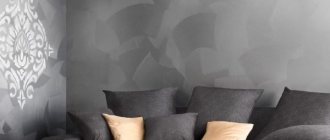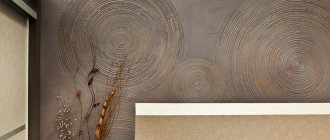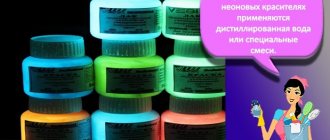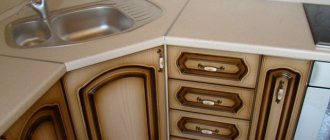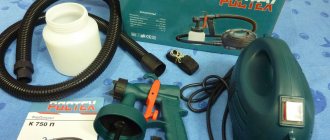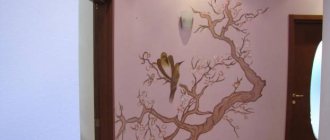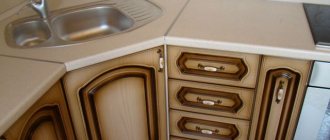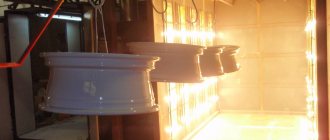Hello readers of my blog! Today we will talk about how to make washable wall paint with your own hands. It would seem that the matter is not tricky, but when you are faced with this problem, you have to think about how to do it correctly, what preparation to do, what materials to choose. Thus, I decided that this article would be useful to someone, and I am devoting my efforts to this subject. In it, I will answer a number of questions that will arise immediately before How to make washable wall paint with your own hands, and some even after that. This topic is quite broad, because before work, thorough preparation is necessary, but how to do this? And this is a separate topic. You can learn about all this in great detail in the article below.
How to make your own paint tinting
No matter how wide the selection of paint colors in the store is, sometimes it is not enough. In this case, tinting will come to the rescue - mixing a light base paint and a colored pigment. This allows you to get a wide variety of colors and shades.
Painting walls with water-based paint with a pattern
Decorating rooms in apartments and country houses is a complex and lengthy process that requires attention and theoretical knowledge. These days, people are trying to do their own redecoration. For finishing, water-based paint is often used, which has an acceptable cost. The demand for such paints is explained by their technical characteristics; let’s look at them in more detail.
The choice of tools depends on what effect you want to achieve.
Using a roller, the paint is distributed evenly over the surface. A brush is needed for painting hard-to-reach areas of the wall. The sponge is suitable for creating a relief pattern on the wall; for this you will need a thick solution of water-based paint. Armed with rollers with different pile lengths and hardness, you can achieve certain effects.
Pour paint in small portions into a tray; you can buy it at a hardware store. We paint the wall along the perimeter with a brush so as not to stain other walls with paint. Next, use a roller to paint the original surface.
What types of paints and bases are there, and which combinations are the most difficult to process?
On some walls the paint sticks very firmly and removing it takes a lot of work, but on others the process of peeling off is quite easy.
The most durable connection is formed by oil paint with a concrete unplastered base. The most difficult option for removing such a coating is the ceiling.
To correctly choose the method that is right for your particular case, you need to know several factors:
If you can decide more or less easily on the first three points, then this is unlikely to happen with the type of paint.
However, you can try to find out by trying it on a small section of the wall, starting with less labor-intensive methods. You should always count on the worst case scenario - oil paint and an unplastered concrete base. It is the worst to clean, especially if the ceiling is painted with it.
Another important detail in solving this issue is the tool.
Types of water emulsions
Currently, there is a division of all water-based paints into four types, depending on the chosen polymer:
Water-based acrylic paints
This type is considered to be in greatest demand in the modern construction market. The main component of such materials is acrylic resin. In addition, latex is often added to the composition, which increases the resistance of the coating to water. Surfaces painted with acrylic paints can be washed with plain water without fear of deterioration in appearance. Manufacturers of such compositions indicate on the labels that the finished coating can be washed 4000-5000 times.
A double layer of acrylic composition, which contains latex filler, can remove cracks with a diameter of 0.5-1 mm. It fits perfectly on brick, concrete, wood, and glass surfaces. A similar composition is suitable for decorating metal surfaces. Among the examples of such a coloring agent, Fr. This type is safe, does not have an unpleasant, specific odor, and dries quickly enough.
Water-based silicone materials
They contain silicone resins. Such materials are quite expensive, they are suitable for all types of surfaces, and create a vapor-proof coating. With their help, you can decorate cracks up to 2 mm, even in rooms with high humidity, without fear of the appearance of fungus.
Advantages and disadvantages
Water-based paint has many advantages. Let's look at them in more detail:
- it dries out pretty quickly. A few hours will be enough for complete drying;
- water-based wall paint is environmentally friendly and will not cause any harm to humans or nature;
- the finish does not have a strong odor, which is also a significant advantage over competitors;
- a large selection of shades and the opportunity to create your own. Stores often sell a white base, to which the necessary dye is purchased. You yourself choose the shade that you like, and then, independently or with the help of a specialist, the base is mixed and a ready-made solution is obtained for work;
- The process of painting the wall itself is quite simple and will not take much time and effort.
Water-based paint has far fewer disadvantages than advantages. The main disadvantage is that it is necessary to paint the wall only at a temperature of at least 5 degrees.
Features of making water-based paint at home
The budget option for making water-based paint at home is in no way inferior in quality to its “industrial counterpart.” This method is especially relevant if all the components are available and it is impossible to visit a hardware store.
If necessary, you can independently prepare water-based paint for finishing walls and ceilings at home. For this we need:
Of course, if it is possible to replace the most important component (chalk) with zinc white, it will be even better.
You can adjust the desired level of viscosity of the water-based emulsion, which will be more convenient to work with. If a snow-white color is required, you will need to add blue.
Before use, chalk (whitewash) must be sifted through a sieve (step 1).
First, glue is added to the water, and then chalk. (stage 2)
After thorough mixing, the resulting solution is again filtered through the filter. To increase plasticity, it is customary to add 50-60 grams of washing powder. The proportions of the process are as follows: 10 liters of water will require 6 kg. chalk (whitewash) and 1 kg of glue. For wall finishing, 500 grams more glue is usually added.
Creative and creative individuals have long appreciated the technology of tinting water-based paint, which gives surfaces absolutely any color and helps bring your wildest fantasies to life.
Color is a special additive to the “water emulsion”, giving it a characteristic tonal shade.
Colors are divided into: organic and inorganic. As the name suggests, the first type consists of organic pigments that are distinguished by bright and rich colors. Their significant drawback is their lack of resistance to direct sunlight. The same cannot be said about colors with a predominance of inorganic pigments in their composition. Although its color scheme is much paler.
After adding washing powder to the resulting solution (exclusively if desired), you can begin the direct tinting process. To do this, you need to gradually add color and stir the paint so as not to overdo it with the selected shade.
To add colored shades to water-based paint, you can actively use home remedies that are always at hand. These can be fabric dyes or even ordinary gouache. At the same time, many designers claim that it is difficult to obtain an even tone over the entire plane of the surface being painted when using this method.
Please note that the color of the paint in the liquid state will be brighter than the color that is applied to the wall or ceiling. Therefore, you need to mix until the color in the paint dissolves completely and does not leave any streaks.
It is necessary to dilute paint with color over the entire area that you intend to paint, since it will be quite difficult to obtain an identical tone the next time you mix it. When painting surfaces, it will be convenient to pour the diluted paint into a tray, moisten the roller in it and apply the paint to the wall, rolling it over the entire surface. It must be applied in at least two layers.
On this topic:
DIY tinting
If tinting paint is done manually, then it is better to do it in the room in which it will be used. This will help you achieve the perfect color for the lighting conditions of a given room.
When tinting paint with your own hands, you should remember that no matter how hard you try to remember the proportions, you will not be able to perfectly repeat the same color a second time; the differences will be noticeable to the naked eye. Therefore, the paint must be diluted in a large container so that there is enough for the entire room at once. It is better to add 5-10% in reserve to the paint consumption per 1 square meter indicated on the packaging.
It is advisable that the white paint and color be produced by the same company.
Manufacturers may have significant differences in paint production technology and its composition, so it is better not to take risks, otherwise you may end up with a coating not only of a strange color, but also with poor performance characteristics.
As a rule, a paint tinting table is included with the color scheme, demonstrating the possible proportions of mixing colors.
Large manufacturers, for example, Tikkurila, offer customers entire catalogs of paint tinting, available in paper and electronic form.
To stir the paint, you must use a mixing attachment on a drill or hammer drill, since long and thorough mixing of the mixture by hand will still not give a uniform result. The paint is mixed until a mass of uniform color and density is obtained.
The color of the paint in the container may differ slightly from what you get when applying it to the surface.
To see how this shade will look on the wall, you should prepare a test mixture (trying to remember the exact ratio of the components), and then paint a small area and wait until it dries at least a little. Although even if the proportions are observed the second time, it will not be possible to obtain absolutely identical colors, a test coloring will still help to get a rough idea of the result. It should be remembered that as it dries, the color of the walls will become somewhat less bright and saturated.
If you don’t like the resulting color, you can change it by adding either a little more color or, conversely, white paint. If water-based dyes were used, the mixture can be diluted with water.
Advantages of water-based paint
The use of this popular material provides a number of undeniable advantages, including:
- absence of sharp specific odors that ordinary paint can retain for weeks;
- a safe composition that does not require the evacuation of residents from the apartment during painting work;
- high consumer characteristics and design capabilities;
- ability to fit well on any surface (except metal);
- easy to maintain (clean with a damp cloth);
- After completing the work, the paint is easily washed off from the skin and tools.
quick drying - the ceiling can be used within two hours after painting;
Production technology
The production process of water-based paint consists of several stages. At the first stage, the aqueous solution of the polymer dispersion is combined and thoroughly mixed with fillers and pigments. This mixture is in the form of a paste that is dispersed.
The next stage is to add the necessary additives, as a result of which the output is water-based paint that meets all standards.
At the final stage, the finished product is filtered through mesh filters and packaged in containers. Work on the production of water-based interior paint must be carried out in rooms where the air temperature does not fall below +5°C.
How to choose water-based paint?
Water-based paint presented on the modern construction market is divided into several types. They differ from each other in composition, as well as production technology.
These are types such as:
- paint with a mineral composition;
- silicate-based paint;
- acrylic emulsion;
- silicone based paint.
Mineral-based paint is made using cement or slaked lime. This is not the highest quality type of material, as its service life is short. Often this paint is used to paint brick or concrete surfaces in non-residential premises. Its low price allows it to be used to inexpensively decorate large areas.
Mineral water-based paint for ceilings “Odyssey Premium”
The production of silicate paint is based on liquid glass, and pigments of natural or synthetic origin are responsible for giving it color. This paint has good durability, which allows it to last 20 years or more. Disadvantages include sensitivity to humidity, due to which silicate paints are not recommended for finishing bathrooms and kitchens.
Acrylic paints are water-based emulsions of acrylic resins. This is a beautiful, durable material, odorless, resistant to mechanical stress and has a washable coating. But acrylic paint is completely impermeable to water vapor and other gases, so it can only be applied to completely dry plaster. That is, the plastered surface can be painted only a month after it has completely dried.
Silicone paint is by far the best type of water-based paint. It can dry without defects even on plaster that is not completely dried, and can be a good solution for rooms characterized by high humidity (bath, sauna). In addition, it perfectly hides cracks formed on the ceiling surface. A ceiling painted using this type of paint can even be washed with a brush and synthetic detergents.
Water-based paint, depending on the composition, can produce a matte, semi-matte or glossy surface. Matte paints can mask minor defects and visually increase the height of the room. The disadvantage of such coatings is that they are difficult to clean. Glossy paints wash well and are abrasion resistant, but they will not be able to hide ceiling flaws. The optimal solution is to use semi-gloss or semi-matte paints.
The painted ceiling can be matte or glossy
What you need to know before purchasing items to paint
Advice! To paint walls use brushes 20-25 cm in size, and for corners 5-15 cm
- To paint smooth walls, buy a velor roller with short pile, for textured walls - medium length, and rough ones - long. The rollers should fit comfortably in your hand and not be very heavy.
- When exposed to low temperatures, the paint loses its properties, so before purchasing, make sure that the cans have been in a room at room temperature.
- For an approximate calculation of paint, consider that the average consumption for smooth walls is 150 ml per 1 m2, for a rough surface 200 ml per 1 m2. But buy 10-20% more water-based emulsion for reserve.
Along with the paint, purchase a convenient roller and brushes for painting corners
- If you want to paint the walls in your kitchen or bath, do a little experiment first. Cover a small sample with the purchased composition and place it under water pressure for 15 minutes. If it starts to wash off or bubble, it means it is not moisture resistant and is not suitable for these rooms.
Some subtleties of choosing an emulsion
- When buying white paint, it is better to choose one that contains titanium dioxide as a color. This compound gives a pure and even white color without other shades.
- To produce the material, ingredients imported from Europe are used, so the cost of good paint cannot be very low. You should not buy a suspiciously cheap emulsion; most likely, it will be counterfeit.
- If the VD paint code is marked with the number 1, then it is not suitable for painting the ceiling, since it is intended for the external walls of buildings. For internal surfaces use paint marked VD2.
Paint consumption is calculated based on the characteristics specified by the manufacturer on the label. Average consumption rates are in the range of 150-250 g/m². But if you need to tint the paint, then the solution needs to be prepared in slightly larger quantities. After all, if there is not enough of it, it will be quite difficult to get exactly the same shade.
Paint consumption also depends on the characteristics of the original surface, its smoothness and absorbency. By the way, cheap water-based paint, as a rule, is consumed more, so such an attempt to save money can cause even greater waste.
When buying paint, you need to carefully study all its characteristics so that the choice is informed and competent.
Important! If the paint is stored incorrectly, for example, in the cold, its structure will be damaged and its consumer characteristics will be lost. Therefore, it is important that the seller has an insulated warehouse for storing it.
Comparative characteristics of popular brands of water-based paint
Tips and tricks
Both Russian and foreign manufacturers have a large selection of types and shades of colors.
Domestic paints not only have a better price, but are also not inferior in quality, so there is no point in chasing expensive foreign products. It is recommended to use snow-white rather than just white paint as a basis for tinting.
The latter often has a yellowish tint, which can greatly affect the tinting result.
Don’t get carried away and pour half a bottle of dye into the base at once.
Even a few drops of color can already noticeably change the color of the paint. Colorants can be used not only to obtain the desired shade of paint, but also added, for example, to plaster.
Buying tools
A roller with a long handle is the most suitable tool for painting the ceiling. It is advisable to purchase a fur roller, which gives better quality coloring and is economical in consumption. A foam roller is cheaper, but it strongly absorbs the solution, increasing the consumption of the emulsion, and can also form bubbles. If you have a good fur roller with a short handle, then you can purchase a telescopic rod for it, which will make it easier to work with the ceiling.
Reference! The use of brushes for painting is not recommended, as they leave streaks, and the use of a spray gun is fraught with increased paint consumption and the formation of unpainted areas on the surface.
Video - Choosing a paint roller
A ditch is a small container into which paint is poured. With its help, application of the material will be better and easier. The cuvette makes it possible to squeeze out the emulsion well, and subsequently facilitates the cleaning process.
Paint brush for painting joints formed by wall and ceiling surfaces, as well as for working in other places inaccessible to a roller.
To prepare the ceiling surface you will need the following tools and materials:
- metal spatula or metal brush for removing paint and whitewash;
- a roller intended for priming, or a special brush;
- skin and eye protection products (gloves, goggles, hats, disposable clothing);
- primer;
- putty.
Tools needed to prepare and paint the ceiling
Recommendations for painting work
As when working with other paints and varnishes, before you start painting with water-based paint, you must carefully prepare the surface to be painted - clean it from dirt, dust and remnants of the previous paint. It is also advisable to smooth out surface unevenness with putty and then sand it. When carrying out painting work in cold weather, the can of paint is first kept indoors for at least 24 hours, and then the can is opened and any films and inclusions are removed from the paint surface. It is better to immediately paint 10% more paint by volume than was previously calculated, since the actual consumption always exceeds that specified by the manufacturer, and it will not be possible to accurately tint the additional volume of paint.
If you first apply a layer of primer to the surface, then when painting you can significantly reduce the consumption of water-dispersed paint.
StroikaPortal.Ru | All articles | In the section: Paints and varnishes | Question answer
Preparing the ceiling surface
The paint application procedure should be carried out only on a completely clean and leveled surface . To prepare the ceiling, you need to carefully examine it for traces left from whitewashing, drips, and old paint. If any are found, they must be removed to the very base.
The whitewash is removed with a metal spatula or brush after wetting with water and swelling. Experts recommend not to moisten large areas of the ceiling at once, but to do it in stages, as needed.
If there was wallpaper on the ceiling, then they are also removed by moistening with water. If there is an old layer of water-based paint on the ceiling, it also needs to be removed, but this process is not easy. To begin with, the coating is heavily moistened once (with a roller or using a spray), and after 20 minutes the procedure is repeated.
Wetting the ceiling with a roller
Applying texture or pattern
Textured painting of walls with water-based paint looks very good. To create a design, you can use a special roller or stencil, but you can also make do with improvised means, using a sponge, a piece of foam rubber, a crumpled piece of fabric or plastic film.
These simple devices are simply dipped in paint, the excess is removed, and then an unusual pattern is “printed” on the wall. For example, a sponge dipped in paint will leave a fine pattern on the surface, creating a sense of volume. You can also cut out a figure from it and leave imprints in the form of stars or hearts on the surface.
A wad of fabric or polyethylene will allow you to imitate a marble coating; the main thing is to act quickly and carefully, avoiding splashes. Before you begin this exciting process, it’s worth practicing a little, at least on a sheet of cardboard.
If you have the desire and time, you can paint the wall with your own hands, choosing some simple ornament in the form of, for example, small flowers, butterflies or snowflakes. Patterned walls are often included in the design of a children's room.
Attention: the design is applied to walls that have already been painted and dried, and the paint must be thicker in consistency for the image to be clear.
How to make a texture roller from a cellophane bag. Video
Ceiling painting
Immediately before painting, the emulsion must be mixed well, and in some cases diluted with water. Often the first layer is painted with paint diluted to the consistency of milk, and the second without dilution.
Scheme for painting the ceiling with water-based emulsion
To properly prepare the material, you must follow the instructions.
Important! If the paint is not mixed well, stripes may form on the surface that differ in shade from the main coating.
Stirring the paint can be done with a drill with a suitable attachment for this purpose (in the form of a mixer), then pour a small amount of the solution into the ditch.
The first step is to use a paint brush to paint twice around the perimeter of the ceiling, paying special attention to areas inaccessible to the roller. The boundaries of paint application need to be shaded.
The main area of the ceiling is painted with a roller. First, the tool is dipped into the solution, after which it is rolled along the relief part of the cuvette, squeezing out excess paint.
Reference! Professionals believe that high-quality paint can be applied to a surface only with an almost dry roller.
Painting should begin from the corner of the ceiling, parallel to the window. It is necessary to constantly monitor the quality of paint application in order to completely paint the surface. To fully monitor the results of your work, you need to take a couple of steps to the side, examining the surface at oblique angles. Inspecting the ceiling at right angles will not be informative enough. If bald spots appear during the process, they must be eliminated before the initial coating layer is completely dry. Otherwise, the color may be uneven and stains may form on the surface of the ceiling.
Instructions for painting the ceiling with water-based paint
The paint must be rubbed well so that the applied layer is thin. Firstly, this will ensure uniform coverage, and secondly, a thin layer will dry much faster than a thick one. To ensure uniform application of the emulsion, you need to press the roller with the same pressure. Professionals recommend painting the entire ceiling surface at one time, without taking long breaks in work. This is due to the fact that a fresh layer of coating applied to dried paint can form an unaesthetic stripe.
After the first layer of material has been properly applied to the surface, it should be allowed to dry thoroughly for 2-3 hours. Then the ceiling should be painted with another layer of paint, applying it from the corner, but perpendicular to the windows. This approach will ensure uniform application of the material, absence of stains, streaks and unevenness.
Water-based paint is an excellent and inexpensive alternative to newfangled solutions for ceiling finishing. When applied correctly, it can delight the eye for many years with a high-quality aesthetic coating that is resistant to abrasion and easy to maintain.
Video - Do-it-yourself whitewashing of the ceiling with water-based paint (instructions)
Characteristics
Before purchasing water-based paint, first carefully study its basic properties. These include: composition, consumption, viscosity of the substance, weight, storage conditions and service life.
It includes latex, filler, thickener and antiseptic.
The consumption for the first layer is approximately 150-200 ml/m2. The amount of material that will be spent depends on the wall itself.
Viscosity shows how much water is needed to dilute the paint. This is measured using a viscometer and should be around 40 when painting with a brush and around 25 when using a spray gun. The weight of the product is approximately 1.35 kg/l.
Drying time depends on basic air conditions and can take from 2 to 24 hours. The optimal temperature for painting should be more than 20 degrees, and humidity should not exceed 65%.
How to choose water-based paint for the ceiling
- Advantages of water-based paint
- How to choose water-based paint for the ceiling Classification of water-based paints
- Choosing paint according to purpose
- Selection according to the type of finished coating
- Useful tips for quality selection
Even now, when there are many alternative finishing options, painting the ceiling is very popular among those who decide to renovate. This is explained by the high decorative qualities of the surface at low costs. Since the ceiling in an apartment or house can be made of a wide variety of materials, for example, wood, plasterboard, concrete and others, you need to choose the right coating and tools. Water-based paint is ideal for any coating. In this article we will tell you which is the best water-based paint for the ceiling and how to choose the one that is suitable.
Advantages of painting walls with water-based emulsion
The main advantages of this type of staining include:
- Drying speed. Painted walls are suitable for further work after 2-3 hours.
- No pungent odor.
- It does not contain harmful chemicals that can cause allergies.
- A very simple method of painting: you don’t need to use special solvents, your hands can be washed well after it.
- You can get any color yourself by mixing colors, or diluting them to a certain shade.
- Thanks to special additives, it is suitable for walls with high humidity levels: kitchens, bathrooms, toilets.
- The composition of the paint ensures good adhesion to the wall, which is why cracks and chips do not form for a long time.
- The water-based emulsion ensures that the surface is vapor-tight, so that fungus and microorganisms will not appear on the wall.
To give the paint the desired shade, add a special toner.
Advantages of water-based paint
This coating is ideal for any surface in the house, except that it is not worth painting metal, since the water contained in the composition can cause corrosion.
Let's look at the main advantages of using water-based emulsion:
- Ease of creating a unique interior and setting fashionable accents, as well as the ease of quickly changing the shade of the coating. This is explained by the ease of application with your own hands, without prior agreement with specialists, and the speed of removing the coating, if necessary, by wetting and removing with a spatula.
- The ability to achieve any shade by mixing white and the desired amount of color. You can do this with your own hands or using a special mechanism that measures the amount of color for a certain volume of paint. Also, when purchasing water-based paint, you can use this service at a hardware store. As a rule, mixing is inexpensive or completely free with purchase. Advice! When painting a large area that will require a significant amount of material from several cans, it is better to entrust mixing to professionals to avoid mismatching the tone.
Types of colors
The composition of dyes can be organic or inorganic. The first type allows you to get brighter and more saturated shades, but over time this coating noticeably fades. Inorganic colors are presented in a much narrower range of colors, but are resistant to weathering and ultraviolet radiation.
Colors are available in the form:
Dry dyes have the most favorable price of all three types. Among their main disadvantages is a small selection of colors and the difficulty of accurately adjusting the shade.
Before adding to the white base, the powder must be diluted in a liquid suitable for its type - water, drying oil, etc. and mixed thoroughly.
Liquid dyes are most convenient to use. They allow you to change the shade of color very effectively.
You should choose colors in accordance with the type of paint in the room (water-based, acrylic, oil, etc.). If some area of the surface needs to be highlighted with a color accent, then the color can be used even undiluted.
Although color pastes are convenient to use, they themselves may have an uneven color. As a result, when mixed, you may end up with an unexpectedly light or dark shade. When using them, it is important to observe the proportions - the amount of paste for a certain volume of base paint should not exceed that specified in the instructions.
Choosing a color for the walls
When choosing the color of a room, you must also adhere to certain rules. You can choose the color of the wall using the photos that were used in the article.
If the windows in the room face south, then cool shades would be a good choice: blue, blue, purple, green. If the windows face north, then it is better to use warm colors: red, crimson, pink, light green, orange.
When choosing a color for the wall, you should not have any complications, because water-based paint has a lot of shades. This means that any color idea will be realized.
To summarize, we can say with confidence that water-based paint is an excellent choice for finishing walls and other surfaces. The main thing is to apply it according to the instructions and under no circumstances rush, then the result will be more than good. For walls in the kitchen or nursery, the best paint is washable, due to the easy removal of dirt from its surface. We recommend using a roller as a tool; it will allow you to do the job quickly and efficiently. To learn more about water-based paint, we recommend watching the following video:
In order to prepare water-based paint yourself, you need to clearly understand what it is. From the point of view of colloidal chemistry, this is a dispersion system.
So the basis of this paint is small particles. And therefore, in order to prepare water-based paint at home, its base, such as whitewash or chalk, must be finely crushed and sifted through a sieve. Then your paint will be uniform and stable and can be stored.
How to hang wallpaper?
Read what you need to know to hang wallpaper on walls that are painted with water-based emulsion, and how to do the job correctly.
- Choose the right wallpaper. Thick vinyl and washable ones are too heavy, take a long time to dry, and if the adhesion to the surface is poor, they quickly begin to fall off. Non-woven fabrics on a vinyl or paper basis are glued only to the treated surface. Liquid wallpaper is good: it hides unevenness and is highly durable.
- Peeling areas must be cleaned off, damage and unevenness must be repaired with putty (for example, Vetonit brand), and after it has dried, the surface must be leveled with a fine-grain abrasive mesh or a grater with sandpaper.
- Vacuum the base to remove any adhered dust.
- Treat the surface with a deep penetration primer using a wide brush or roller.
- Layer upon layer is applied perpendicularly. For a dark wall and light wallpaper, you need a primer with a color pigment: it will paint the surface a light color.
- Mark the base using a plumb line.
- Do the gluing according to the standard scheme: one person glues the canvas on top, along the marks, the second - on the bottom. The glue is applied with a roller or brush. Finally, remove excess glue and air bubbles with a spatula or wide brush, moving from the middle of the sheet to the edges.
Preparatory work
Before painting walls with water-based paint, it is necessary to prepare the surfaces. The fact is that this paint is not suitable for finishing walls treated with whitewash or oil paint.
Removing old whitewash and paint
If the layer of whitewash is thick, then it will be necessary to make many shallow cuts over the entire area of the wall, moisten the surface generously with water and leave for half an hour. After this, wet the coating again and wait until it gets wet. Then simply remove the whitewash with a spatula, and at the end wash the walls with a sponge. If the layer is small, then you can do without notches.
After wetting, whitewash can be easily removed using a metal spatula
If the walls were previously painted with water-based paint, then the process of removing it is the same as in the case of whitewashing. But if oil paint was used, it is more difficult to remove the coating. In most cases, a hair dryer helps: use it to heat the surface, then scrape off the material with a spatula.
If the paint is too old, a hair dryer may not help. Then removal technology is used using chemical removers. You need to open all the windows and doors in the apartment to create a draft, put on work clothes, rubber gloves and a respirator. Dampen a rag in the solvent, treat the surface with it, wait the specified time and wash the material off the wall. This process must be repeated until a clean base remains.
The safest way to remove oil paint in all respects is to use a hair dryer.
Also, before painting walls with water-based paint, it is permissible to use mechanical methods of removing paint. The simplest is sanding the surface manually or using a grinder. If you have the necessary tools at hand, you can use a drill with an attachment in the form of chains or a crown for drilling socket boxes.
Puttying and priming
If the walls are perfectly smooth and there are not a single crack on them, then you can skip this point. But, as practice shows, such situations happen rarely; more often preparation is required. It is necessary to tap the wall with a hammer to identify weak points, then inspect the surface and pick out cracks with a spatula to remove small fragments from them. If large potholes have formed, they are sealed with cement-sand mortar. Then the starting putty is applied to the entire area with a spatula; after drying, the surface must be primed and a thin layer of finishing putty must be applied. Finally, the walls are treated with sandpaper or a grinding machine.
Perfectly leveling walls with putty is a difficult task, so it’s better to hire professionals
On a note! The primer is applied using a roller mainly in two layers, and the second layer should be applied only after the first has completely dried. In addition to increasing adhesion, this material helps reduce paint consumption.
Popular manufacturers
In modern construction stores you can find a wide selection of different brands. Depending on the volume and type, water-based paint is produced in cans and ordinary buckets of various capacities - from one liter to forty kilograms. Some of the most successful manufacturers include:
- "Tikkurilla " A famous Finnish brand that has been one of the market leaders for many years. Painting with Tikkurilla water-based paint guarantees the quality of painting work and the durability of the coating.
- "Dufa " German enamels from one of the largest European concerns for the production of paint and varnish coatings. Dufa black matte water-based paint is one of the most popular in its segment.
- "Aura" . A reliable Russian manufacturer that produces a wide range of paints with different effects, including water-based and deep matte.
- "Marshal" . has been operating on the Russian market for more than twenty years, offering water-based paints for metal, as well as for wood and mineral coatings.
- Dulux . One of the most famous English developments is the “Magic White” ceiling enamel. Its peculiarity is that after painting the ceiling with emulsion paint, the drying composition turns from pink to white, allowing you to reliably check the absence of untreated areas and telling you what else needs to be done.
- "PARADE" . Eco-friendly paints have received a certificate for use in children's and medical institutions, which confirms their safety.
- "Pufas" . The main emphasis in the German company's product line is super-glossy and matte white and black water-based paints, which are suitable for interior work in any room.
- "Rainbow" . One of the most loyal, in terms of price, manufacturers is the Russian one, which produces high-quality products accessible to the mass consumer.
- "Vincent " Vincent interior paints are in demand both in the domestic and foreign markets for painting and construction work.
